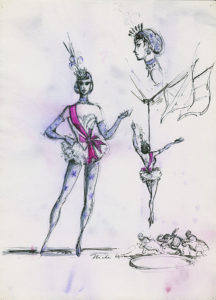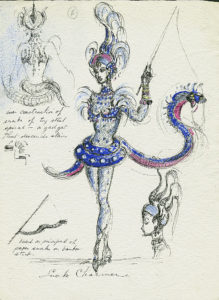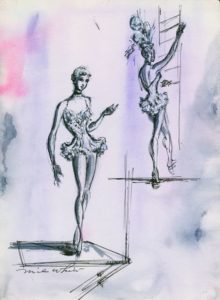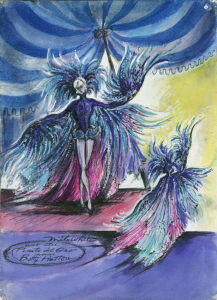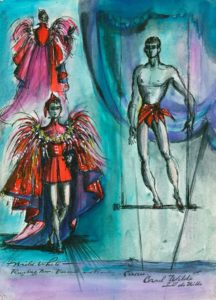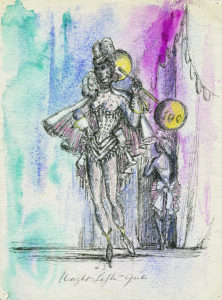Trust & Transformation: Circus Costume Designs by Miles White
There are few artists as influential to circus showmanship as the twentieth-century costume designer Miles White. White intended to pursue a career in high fashion, but a turn of fate diverted him to a twelve-season career with the Ringling Bros. and Barnum Circus where he revolutionized how performers looked under the big top. White went on to become a lauded designer for Broadway shows, carrying his circus influences with him. He eventually won two Tony Awards, and he was nominated for three Academy Awards.
Until the mid-1800s, acrobats’ attire was typically assembled out of readily available materials by the performers’ themselves. One of the first specialty costumes was designed by a gymnast from Toulouse, France, by the name of Jules Léotard. The form-fitting outfit allowed him to move freely and safely while doing dangerous stunts on the flying trapeze, an apparatus which, remarkably, he had also invented and debuted in Paris in 1859. In addition to its practicality, the garment accentuated Léotard’s muscular physique, which added to spectators’ delight. New possibilities opened for stylized performance wear, but it would take nearly ninety years before an entire show’s worth of circus costumes would be designed around a unifying theme, this time courtesy of Miles White.
Miles White was born in Oakland, California in 1914. After attending the University of California, Berkeley, he sought his fortune in New York City. Sketches of White’s work made their way to Marjery Fielding, a producer of nightclub revues. Enchanted by his designs, Fielding put them to use on the club stages and in the Broadway musical “Right This Way”—White’s professional debut—which opened at the 46th Street Theater in January 1938. It was through one of Fielding’s shows that industrial designer Norman Bel Geddes learned of White. Geddes had been hired by the Barnum and Bailey Ringling Brothers Circus in Sarasota, Florida, to helm the task of modernizing the “Greatest Show on Earth.” After collaborating with White on the wildly successful skating revue, “It Happens on Ice,” Geddes invited him to help with the task.
Although White would eventually cement his legacy in Broadway costume design, his time in the circus stretched his imagination. “White decided the circus was a magical place and should be a joyful place for people to come to,” says Jennifer Lemmer Posey, the Ringling Curator of Circus. “He took that opportunity to transform people into things that you wouldn’t dream of.” He endowed his designs with bursts of pinks and teals and lemon yellow, a color of which he was particularly fond. Color signaled to spectators that something remarkable was coming, hyping them up for the next act. He was faithful to the idea that every costume should be special, regardless of when in the show it was introduced. He used light fabrics to create whimsical designs that still managed to move seamlessly with the performer’s body, sometimes even sewing dresses with deliberate asymmetry to increase an acrobat’s range of movement. His meticulous craftsmanship and finishes were the perfect complement to the lights, sounds, and visual rhythm for which Bel Geddes had been aiming, and White’s vision of a show unified through its costumes became the standard for many circuses, including FSU’s Flying High.
As Timothy Mack, ringmaster of the Imperial OPA Circus, puts it, “Costumes, in some part, create the show. A performance can only reel in an audience up to a certain point. Without the colorful outfits, the audience will not take our performance as seriously, and the magic that circus is so known for cannot occur. Costumes are essential in the process of gaining the respect, admiration, and trust of the audience.”
Today, Miles White’s sketches are preserved in many museums, including the Metropolitan Museum of Art, the Museum of Modern Art, the Museum of the City of New York, and the Library of Congress. Trust & Transformation at the Circus features nine original costume drawings by Miles White on loan from the Howard Tibbals Circus Collection and the Ringling Museum.
Trust & Transformation at the Circus: 75 Years of Flying High will run from January 13 through March 19, 2022.
